***WARNING - IF YOU KNEE JERKS, EXIT NOW - WARNING***
^
^
^
Regular readers know, I love the Dutch. You thought some British holidays were, in a word; bizarre. Well, the Dutch celebrate Christmas in a, well, ahem, Dutch way. All in good fun, I am sure.^
^
^
I declare DEC "Dutch History Month." To add to your cultural awareness and appreciation of diversity - I will share with you one of the "unique" cultural activities in The Netherlands. Read all about Sinterkaas here.
There is oh, so much here. Do follow the link, but for an American, you cannot get a better telling of the Dutch Christmas story than by the great American author, David Sedaris in the Chapter titled, "Six to Eight Black Men," in his book, Dress your Family in Corduroy and Denim.
In the holiday spirit, I will take the effort to type out most of the Chapter. If you never finished the Hooked on Phonics
....in The Netherlands the children receive presents on December 5, in celebration of Saint Nicholas Day. It sounded sort of quaint until I spoke to a man named Oscar, who filled me in on a few of the details as we walked from my hotel to the Amsterdam train station. Unlike the jolly, obese American Santa, Saint Nicholas is painfully thin and dresses not unlike the pope, topping his robes with a tall hat resembling an embroidered tea cozy. The outfit, I was told, is a carryover from his former career, when he served as a bishop in Turkey. "I'm sorry," I said, "but could you repeat that?"
One doesn’t want to be much of a cultural chauvinist, but this seemed completely wrong to me. For starters, Santa didn’t used to do anything. He’s not retired and, more important; he has nothing to do with Turkey. It’s too dangerous there, and the people wouldn’t appreciate him. When asked how he got from Turkey to the North Pole, Oscar told me with complete conviction that St. Nicholas currently resides in Spain, which again is simply not true. Thought he could probably live wherever hw wanted, Santa chose the North Pole specifically because it is harsh and isolated. No one can spy on him, and he doesn’t have to worry about people coming to the door. Anyone can come to the door in Spain, and in that outfit he’d most certainly be recognized. On top of that, aside from a few pleasantries, Santa doesn’t speak Spanish. “Hello. How are you? Can I get you some candy?” Fine. He knows enough to get by, but he’s not fluent and he certainly doesn’t eat tapas.
While our Santa flies in on a sled, the Dutch version arrives by boat and then transfers to a white horse. The event is televised and great crowds gather at the waterfront to greet him. I’m not sure if there’s a set date, but he generally docks in late November and spends a few weeks hanging out and asking people what they want. “Is it just him alone?” I asked. “Or does he come with some Backup?” Oscar’s English was close to perfect, but he seemed thrown by a term normally reserved for police reinforcement. “Helpers,” I said. “Does he have elves?” Maybe I’m overly sensitive, but I couldn’t help but feel personally insulted when Oscar denounced the very idea as grotesque and unrealistic. “Elves,” he said. “They are just so silly.”
The words silly and unrealistic were redefined when I learned that Saint Nicholas travels with what was consistently described as "six to eight black men." I asked several Dutch people to narrow it down, but none of them could give me an exact number. It was always "six to eight," which seems strange, seeing as they've had hundreds of years to get a decent count.
The six to eight black men were characterized as personal slaves until the mid-fifties, when the political climate changed and it was decided that instead of being slaves they were just good friends. I think history has proven that something usually comes between slavery and friendship, a period of time marked not by cookies and quiet times beside the fire but by bloodshed and mutual hostility. They have such violence in Holland, but rather than duking it out among themselves, Santa and his former slaves decided to take it out on the public. In the early years, if a child was naughty, Saint Nicholas and the six to eight black men would beat him with what Oscar described as "the small branch of a tree." "A switch?" "Yes," he said. "That's it. They'd kick him and beat him with a switch. Then, if the youngster was really bad, they'd put him in a sack and take him
back to Spain." "Saint Nicholas would kick you?" "Well, not anymore," Oscar said. "Now he just pretends to kick you."
He considered this to be progressive, but in a way I think it’s almost more perverse than the original punishment. “I’m going to hurt you but not really.” How many times have we fallen for that line? The fake slap invariably makes contact, adding the elements of shock and betrayal to what had previously been plain old-fashioned fear. What kind of Santa spends his time pretending to kick people before stuffing them into a canvas sack? Then, of course, you’ve got the six to eight former slaves who could potentially go off at any moment. This, I think, is the greatest difference between us and the Dutch. While a certain segment of our population might be perfectly happy with the arrangement, if you told the average white American that six to eight nameless black men would be sneaking into his house in the middle of the night, he would barricade the doors and arm himself with whatever he could get his hands on.
“Six to eight, did you say?”
In the years before central heating, Dutch children would leave their shoes by the fireplace, the promise being that unless they planned to beat you, kick you, or stuff you into a sack, St. Nicholas the six to eight black men would fill you clogs with presents. Aside from threats of violence and kidnapping, it’s not much different than hanging your stockings from the mantel. Now that so few people actually have a working fireplace, Dutch children are instructed to leave their shoes beside the radiator, furnace, or space heater. St., Nicholas and the six to eight black men arrive on horses, which jump from the yard onto the roof. At this point I guess they either jump back down and use the door or stay put and vaporize through pipes and electrical cords. Oscar wasn’t’ too clear about the particulars, but really, who can blame him? We have the same problem with our Santa. He’s supposed to use the chimney, but if you don’t have one, he still manages to get in. It’s best not to think about it too hard.
While eight flying reindeer are a hard pill to swallow, our Christmas story remains relatively dull. Santa lives with his wife in a remote polar village and spends one night a year traveling around the world. If you’re bad, he leaves you coal. If you’re good and live in America, he’ll give you just about anything you want. We tell our children to be good and send them off to bed, where they lie awake, anticipating their great bounty. A Dutch parent has a decidedly hairier story to relate, telling his children, “Listen, you might want to pack a few of your things together before going to bed. Th former bishop of Turkey will be coming tonight along with six to eight black men. They might put some candy in your shoes, they might stuff you into a sack and take you to Spain, or they might just pretend to kick you. We don’t know for sure, but we want you to be prepared.”
This is the reward for living in The Netherlands. As a child you get to hear this story, and as an adult you get to turn around and repeat it. As an added bonus, the government has thrown in legalized drugs and prostitution – so what’s not to love about being Dutch?
Oscar finished his story just as we arrived at the station. He was an amiable guy – very good company – but when he offered to wait until my train arrived I begged off, claiming I had some calls to make. Sitting alone in the vast, vibrant terminal, surrounded by thousands of polite, seemingly interesting Dutch people, I couldn’t help but feel second-rate. Yes, The Netherlands was a small country, but it had six to eight black men and a really good bedtime story.
If you want to hear the author say it, go to minute 25.00 (click the audio links on the 12/7/01 Episode 201) of This American Life.
The rest, I will let be a photo essay. You can't make this stuff up. Cheers!!!


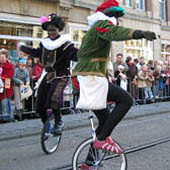
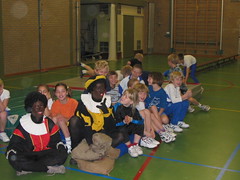
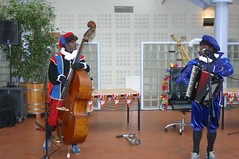
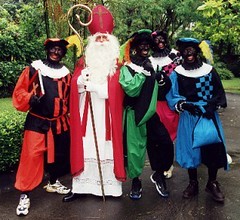
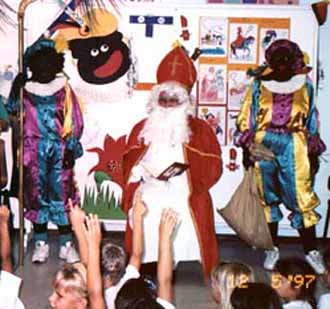
Well the "colorful" characters don't have individual names like Dasher, Dancer, Prancer, Vixen, ect - no, collectively they are called "Zwarte Piet" or "Black Pete." I guess "Black Sambo" was taken.
"Naw," you say, "It isn't that bad. At least they don't have a major sporting goods store in adds having them playing basketball or anything." Ummm, click here. Or sell Black Pete handpuppets.
Yes, they use them in advertising during Christmas like Americans use elves. More here and here.
Next time a "progressive" European talks about how overtly racist America is...throw this their way ... once you get through wiping the tears from you eyes.









No comments:
Post a Comment